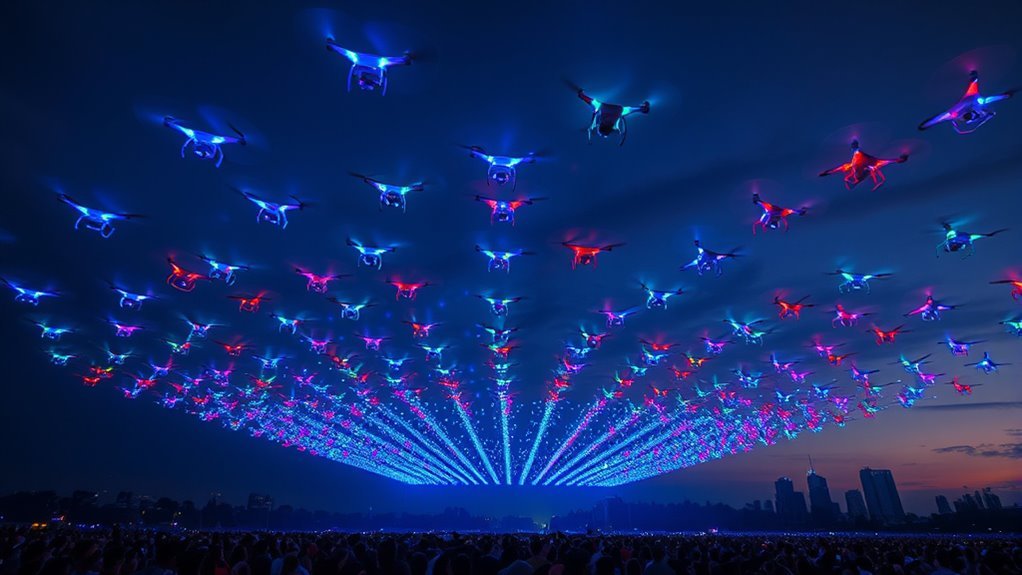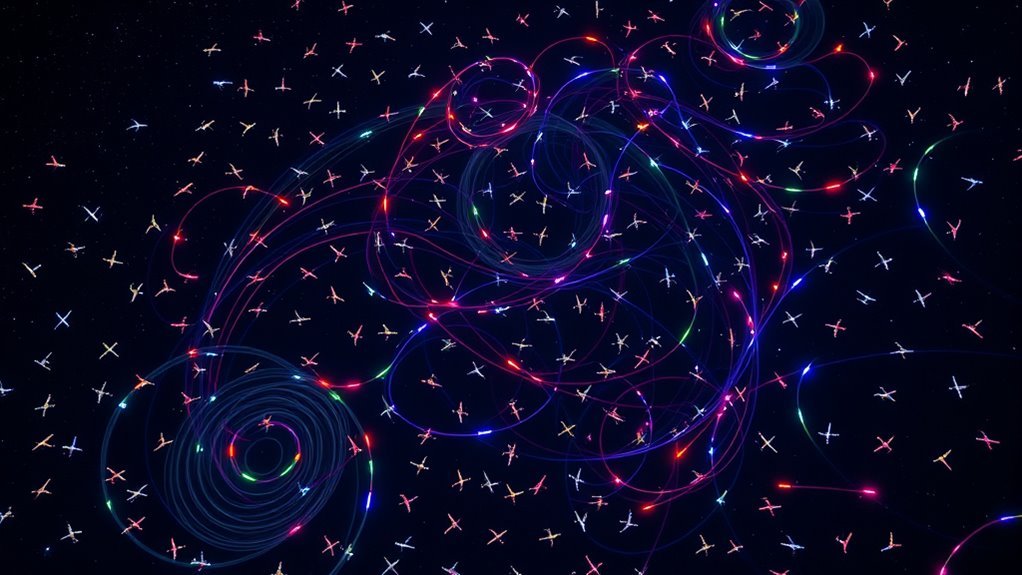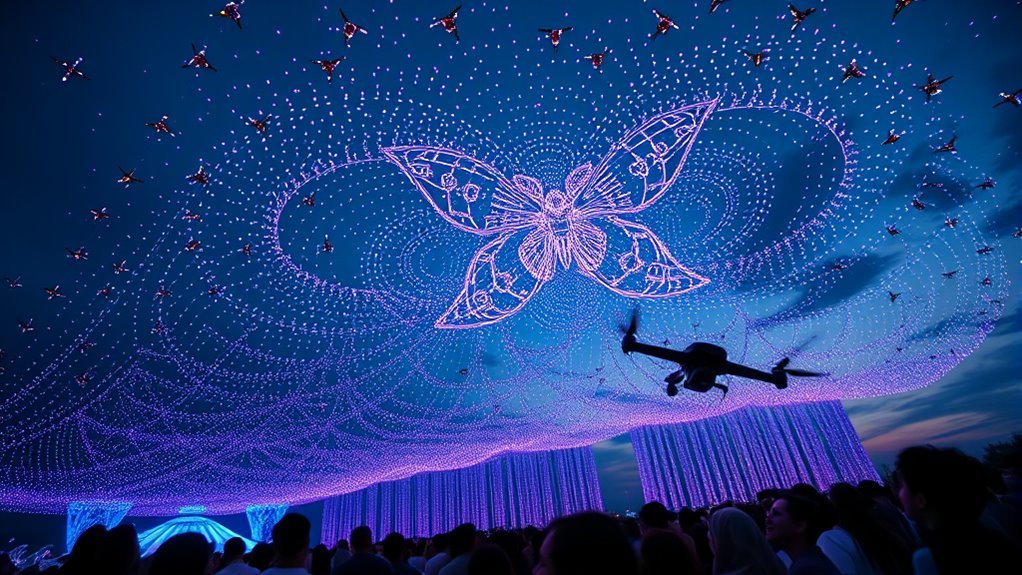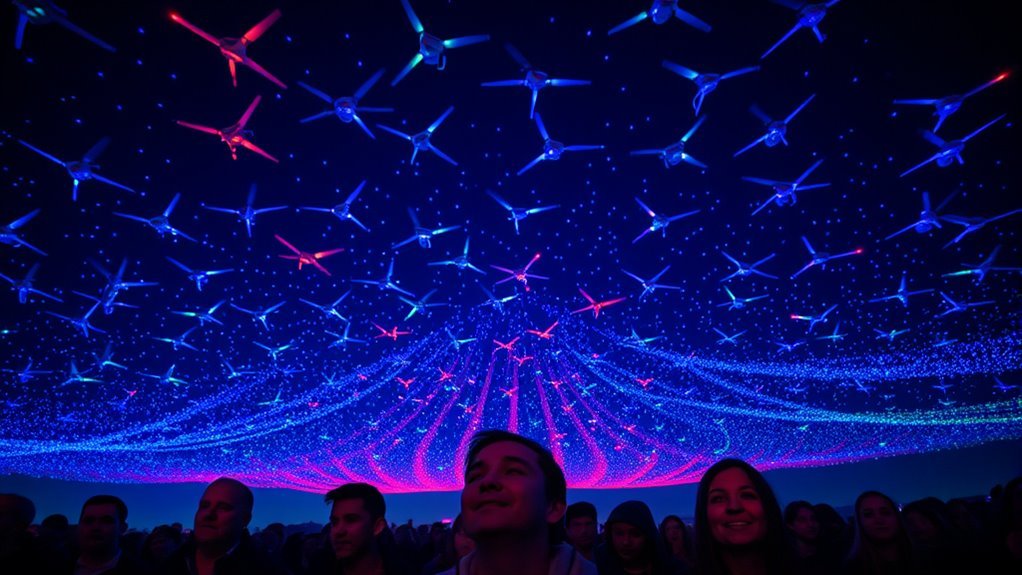Drone light shows work by employing fleets of LED-equipped drones that autonomously execute programmed flight paths. Each drone relies on GPS and real-time data for precise coordination and synchronization, allowing for intricate formations and dynamic color changes. Advanced algorithms calculate safe and efficient movements, while creative programming transforms these flights into enchanting narratives. Safety protocols and regulations guarantee a secure performance environment. If you’re curious about the technology and artistry behind these stunning displays, there’s much more to uncover.
The Technology Behind Drone Light Shows

While you might think of traditional fireworks as the pinnacle of visual spectacle, drone light shows have emerged as a cutting-edge alternative that combines advanced technology with artistic expression. At the core of these aerial displays is sophisticated drone technology, utilizing synchronized fleets of drones equipped with LED lights. Each drone operates autonomously, guided by GPS and real-time data, ensuring precise movements and formations. This level of coordination allows for intricate designs and patterns that would be impossible with conventional fireworks. The integration of software for choreography enhances the visual experience, enabling dynamic storytelling and intricate animations. Innovative technology is a hallmark of leading companies in the drone entertainment industry. As drone technology continues to evolve, these aerial displays are pushing the boundaries of creativity, offering a new form of entertainment that captivates audiences while promoting safety and environmental consciousness. Energy-efficient designs minimize environmental impact, fostering a shift away from outdated pyrotechnics and supporting a more responsible form of aerial artistry aligned with sustainability values.
How Drones Are Programmed for Precision

To achieve precision in drone light shows, programmers rely on sophisticated flight path algorithms that dictate each drone’s movements. These algorithms enable real-time coordination among multiple drones, guaranteeing that formations and timings are executed flawlessly. Additionally, safety protocols are implemented to prevent collisions and guarantee that the performance remains within designated airspace. This coordination is enhanced by DJI’s advanced GPS and RTK systems, which ensure sub-centimeter accuracy in flight paths. The entire performance is made possible through the use of approximately 50 drones that create intricate and captivating visual displays.
Flight Path Algorithms
As the intricacies of drone light shows unfold, the significance of flight path algorithms becomes evident in guaranteeing each drone operates with exceptional precision. You’ll find that these algorithms are intricately designed to calculate ideal flight paths, balancing speed and safety while maximizing visual impact. Flight optimization techniques enhance algorithm efficiency, allowing drones to navigate complex formations seamlessly. By leveraging real-time data and predictive modeling, the algorithms guarantee that each drone adheres to its designated path, avoiding collisions while maintaining synchronization with others. This level of precision is essential for creating the enthralling displays you enjoy. Through continuous refinement, these algorithms evolve, pushing the boundaries of what’s possible in drone choreography, ultimately granting you an unparalleled experience in aerial artistry.
Real-Time Coordination
Real-time coordination is essential for achieving the precise synchronization required in drone light shows, ensuring that each unit responds instantaneously to dynamic changes in its environment. This intricate programming involves advanced drone communication systems that facilitate seamless interaction among individual drones.
Imagine the breathtaking display as drones:
- Dance in unison, creating vivid patterns
- Shift positions flawlessly, adapting to audience reactions
- Illuminate the night sky with synchronized colors
- Execute complex formations, enhancing crowd engagement
- Respond to real-time feedback, making each show unique
These elements highlight the importance of technology in crafting an immersive experience. By leveraging real-time data, drone operators can maintain control, ensuring that each performance captivates and inspires freedom in expression and imagination.
Safety Protocols Implemented
While the excitement of drone light shows captivates audiences, safety protocols are paramount for ensuring both the success of the performance and the well-being of spectators. You’ll find that these protocols include strict adherence to drone regulations and thorough risk management strategies. Before a show, each drone undergoes meticulous programming, incorporating geofencing to prevent unauthorized airspace entry. Operators conduct extensive pre-flight checks, ensuring all drones are in ideal condition. Real-time monitoring systems track each drone’s position, allowing for immediate adjustments if necessary. In addition, safety zones are established around the performance area to mitigate potential hazards. By prioritizing these safety measures, organizers create a mesmerizing experience while upholding the highest standards of public safety and regulatory compliance.
Synchronized Flight Patterns and Coordination

To achieve synchronized flight patterns in drone light shows, you’ll need to understand flight pattern algorithms that dictate each drone’s movements. Real-time coordination systems guarantee that drones respond instantaneously to changes, maintaining harmony throughout the performance. Additionally, formation design techniques play an essential role in creating visually striking displays while adhering to precise spatial arrangements. Moreover, the use of swarm technology allows multiple drones to communicate and coordinate their movements effectively, enhancing the overall performance of the light show. This coordination is further enhanced by AI-driven choreography innovations, enabling drones to adjust their flight paths dynamically based on real-time data.
Flight Pattern Algorithms
Flight pattern algorithms play an essential role in orchestrating drone light shows, enabling seamless synchronization and coordination among multiple drones. By leveraging flight dynamics and algorithm optimization, these algorithms calculate precise paths and timings for each drone, ensuring they move as a cohesive unit.
- Drones dart in unison, creating intricate shapes that dance across the night sky.
- Colors blend and shift, painting a vivid tapestry of light.
- Patterns emerge and dissolve, enchanting the audience in a mesmerizing spectacle.
- Each drone’s position is meticulously calculated, avoiding collisions while enhancing visual impact.
- The result is a harmonious display that pushes the boundaries of aerial artistry, embodying freedom in its most exhilarating form.
Real-Time Coordination Systems
As drones take to the sky, real-time coordination systems become critical for executing synchronized flight patterns. These systems rely on real time tracking to monitor each drone’s position and velocity, ensuring they move in harmony. Advanced algorithms process data from multiple sources, allowing for precise data synchronization among the fleet. This coordination minimizes the risk of collisions and enables complex formations to be displayed seamlessly. By leveraging GPS, IMUs, and communication networks, each drone receives updates in milliseconds, allowing it to adjust its course in response to the movements of its peers. This level of responsiveness not only enhances the visual spectacle but also embodies the freedom of movement that drone technology offers, pushing the boundaries of aerial performance.
Formation Design Techniques
While designing formations for drone light shows, understanding synchronized flight patterns and coordination is essential for achieving visually stunning displays. You’ll need to master formation visualization techniques and choreography optimization methods to create seamless shifts. Consider the following elements:
- Drones moving in perfect unison, creating geometric shapes in the sky
- Dynamic color changes that enhance the visual narrative
- Fluid movements that mimic natural phenomena, like flocks of birds
- Precise timing that synchronizes with music for emotional impact
- Innovative pattern changes that captivate the audience’s attention
The Role of LED Lights in Aerial Displays
Although the technology behind drone light shows has evolved considerably, the fundamental role of LED lights remains crucial to their visual impact. Utilizing advanced LED technology, these displays can achieve stunning color variations and brightness adjustments that captivate audiences. The energy efficiency of LEDs allows for prolonged aerial displays without excessive power consumption, enabling a more sustainable approach to entertainment. With remote control capabilities, operators can execute precise movements and synchronize visual effects seamlessly. Creative programming is essential, as it transforms static light into dynamic art, allowing you to explore limitless possibilities in choreography. Ultimately, the integration of LED lights is what makes drone light shows a revolutionary form of visual storytelling, merging technology and creativity in the sky. Moreover, the synchronized performances of hundreds of drones working in unison elevate the experience, creating enchanting displays that evoke wonder and emotion. This level of synchronization is achieved through advanced movement algorithms, ensuring that each drone operates cohesively as part of a larger artistic vision.
Safety Measures and Regulations
To guarantee the safety of both participants and spectators, drone light shows must adhere to stringent regulations and safety measures. This involves thorough risk assessment and regulatory compliance to mitigate potential hazards. Key considerations include:
- Maintaining safe distances between drones and audiences
- Implementing no-fly zones to prevent accidents
- Establishing emergency protocols for drone malfunctions
- Conducting pre-show checks for equipment safety
- Coordinating with local authorities for airspace management
Creative Design and Storytelling
Creative design and storytelling are integral to the success of drone light shows, as they transform technical choreography into enthralling narratives that engage audiences. By employing visual storytelling, creators can craft a compelling experience that resonates on an emotional level. You’ll find that the synchronization of lights and drones, executed through creative choreography, is essential for conveying a cohesive message. Each drone’s movement is meticulously planned to enhance the narrative flow, allowing viewers to connect with the story being told. Utilizing thematic elements, colors, and patterns, designers create immersive atmospheres that captivate spectators. The interplay between technology and artistry in these performances not only showcases innovation but also invites you to explore the limitless possibilities of aerial storytelling.
Real-World Applications Beyond Entertainment
The artistry of drone light shows extends far beyond entertainment, finding applications in various fields that leverage their unique visual capabilities. You might be surprised to learn how drones can enhance critical sectors:
- Drones in agriculture: Visualizing crop health through colorful aerial displays.
- Emergency response: Coordinating rescue operations with illuminated formations.
- Advertising: Creating brand awareness through stunning light patterns.
- Sports events: Enhancing fan engagement with synchronized aerial displays.
- Environmental monitoring: Highlighting conservation efforts with spectacular visuals.
These applications illustrate how drone light shows can serve essential functions, offering innovative solutions that blend technology and artistry to address real-world challenges. Embracing these advancements can lead to remarkable improvements in efficiency and effectiveness across diverse industries.
The Future of Drone Light Shows
As advancements in technology continue to reshape the landscape of entertainment and communication, the future of drone light shows promises to be both innovative and transformative. You can expect future innovations that enhance interactivity, allowing audiences to engage with performances in real time. Additionally, as the industry shifts towards eco-friendliness, the environmental impact of these shows will be minimized through the use of sustainable energy sources and materials. Drones will likely become more efficient, reducing noise and emissions while offering enchanting visuals. With the integration of artificial intelligence, choreographed displays will become increasingly sophisticated, paving the way for personalized experiences. In this evolving field, you’ll witness a harmonious blend of artistry and technology, ultimately redefining how we perceive entertainment. Notably, current performances often showcase over a thousand drones, enhancing the complexity and vibrancy of displays.
Frequently Asked Questions
How Many Drones Are Typically Used in a Single Light Show?
Typically, a light show uses 100 to 1,000 drones, creating stunning drone choreography. Through precise aerial synchronization, they perform intricate patterns, offering an enthralling experience that balances technology with artistic freedom in the night sky.
Can Drone Light Shows Be Customized for Specific Events or Themes?
Yes, you can customize drone light shows with custom designs and theme synchronization. By integrating specific visuals and music, the drones can create an enchanting experience tailored to your event’s unique atmosphere and message.
What Are the Weather Limitations for Drone Light Shows?
When it’s pouring rain, you can’t expect those drones to dance! Wind restrictions also play an essential role; high gusts can ground your light show. So, keep an eye on the weather for ideal conditions.
How Long Does It Take to Prepare for a Drone Light Show?
Preparing for a drone light show typically requires several weeks, including drone assembly and developing a rehearsal schedule. This meticulous planning guarantees synchronization and performance quality, allowing you to create an enchanting visual experience.
Are There Any Environmental Impacts From Drone Light Shows?
Drone light shows can contribute to environmental concerns, primarily through drone noise and light pollution. While they’re visually stunning, it’s essential to think about how these factors may disrupt local wildlife and community tranquility.

